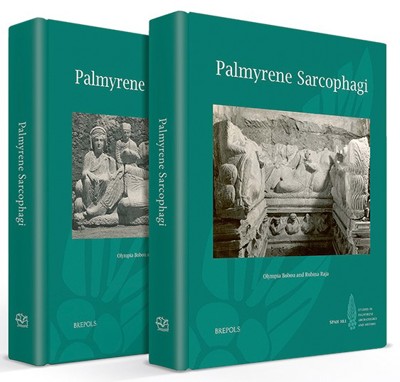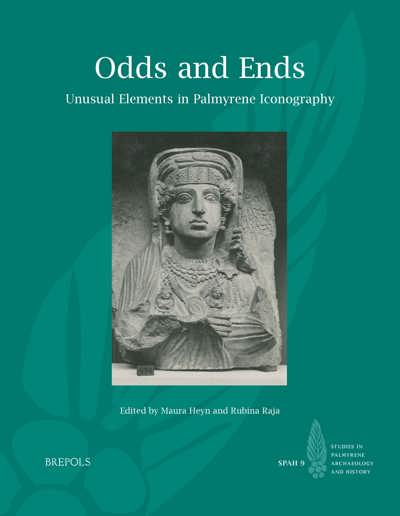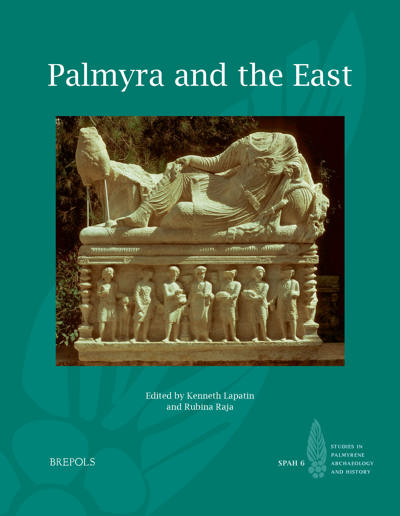
Palmyrene Sarcophagi
Olympia Bobou, Rubina Raja
- Pages:2 vols, 1003 p.
- Size:216 x 280 mm
- Illustrations:722 b/w, 95 col., 1 tables b/w., 2 maps b/w, 9 maps color
- Language(s):English
- Publication Year:2023
- € 320,00 EXCL. VAT RETAIL PRICE
- ISBN: 978-2-503-60466-4
- Hardback
- Available
- € 320,00 EXCL. VAT RETAIL PRICE
- ISBN: 978-2-503-60754-2
- E-book
- Available
"This monumental publication offers scholars and students interested in sarcophagus studies, portraiture, iconography, Palmyra, and the East during the Roman period—and so much more besides—a fabulous opportunity to engage with an impressive collection of materials (…). Palmyrene Sarcophagi is beautifully illustrated and carefully detailed, an important contribution to the study of sarcophagi, Palmyra, and the East under Rome." (Sarah Madole Lewis, American Journal of Archaeology, 128(4), 2024, pp. E114-E117)
"All in all, the current publication builds upon previous scholarship and offers the most comprehensive corpus available to date." (Haggai Olshanetsky, in Antiquity, 99/406, 2025, p. 1163)
Olympia Bobou is an assistant professor at the Centre for Urban Network Evolutions, Aarhus University.
Rubina Raja is professor of Classical Archaeology and directs three projects on Palmyra: The Palmyra Portrait Project; Archive Archaeology: Preserving and Sharing Palmyra’s Cultural Heritage through Harald Ingholt’s Digital Archive; and Circular Economy and Urban Sustainability in Antiquity. She specialises in the archaeology of the Mediterranean and the Levant and has published widely on Palmyra and the region in general.
While the funerary portraiture of Palmyra is rightly world-renowned, up to now, the corpus of sarcophagi from the ancient city has received relatively little attention as a cohesive group in their own right. Comprising sarcophagi, banqueting reliefs and founder reliefs, as well as sarcophagus reliefs, most of these objects share a common iconographic motif, that of the banquet, although other scenes, mostly drawn from the daily life of the city’s caravan leaders and their families, also appear. The emphasis on the banqueting scene in particular reveals the crucial importance of dining in ancient Palmyrene society: for the living, banquets were a marker of social standing and gave hosts a chance to honour the gods and offer an ephemeral benefaction to their fellow citizens, while for the dead, the banquet motif offered the opportunity for the entire family to be depicted together and showcase their wealth and sophistication, as well as their connections outside the city.
This single corpus of material gathered through the Palmyra Portrait Project, is presented in this beautifully illustrated two-volume monograph. Through careful analysis of the portraits, and the costumes and attribute choices that appear in these images, the authors explore how the sarcophagi were used by Palmyrenes to project an image of local pride, while at the same time participating in the visual cultures of the Roman and Parthian Empires between which their city was situated.
Volume 1
List of Figures
Colour Plates
Acknowledgements
Chapters
1. Palmyra and its Funerary Sphere
2. The Portrait Habit in Palmyra and the Funerary Sphere
3. Dated Objects
4 In situ Contexts
5. Iconography
Appendix: The Costume of Reclining Figures
6. Conclusion: Sarcophagi as Vehicles of Elite Identity
Works Cited
Catalogue
Dated by Inscription (Cat. 1–12)
Objects from Tower Tombs (Cat. 13–59)
Objects from Hypogea (Cat. 60–179)
Objects from Temple Tombs (Cat. 180–277)
Credits
Text Image Credits
Catalogue Image Credits
Volume 2
Colour Plates
Catalogue
Objects with Indication of General Context (Cat. 278–288)
Sarcophagi with No Known Provenance or from Secondary Contexts (Cat. 289–444)
Sarcophagi Reliefs (Cat. 445–450)
Fragments from either Sarcophagus Lids or Boxes (Cat. 451–476)
Possible Sarcophagus Fragments (Cat. 477–488)
Heads from Sarcophagi (Cat. 489–683)
Banqueting Reliefs (Cat. 684–729)
Appendix 1. Lost Dated Reliefs
Appendix 2. Lost Reliefs from Tower Tombs
Appendix 3. Lost Reliefs from Temple Tombs
Appendix 4. Marble Sarcophagi from Attica
Appendix 5. Sarcophagi without Portraits
Appendix 6. Objects Known Only through Publications
Appendix 7. Reliefs with Frame, without Portraits
Credits
Catalogue Image Credits




